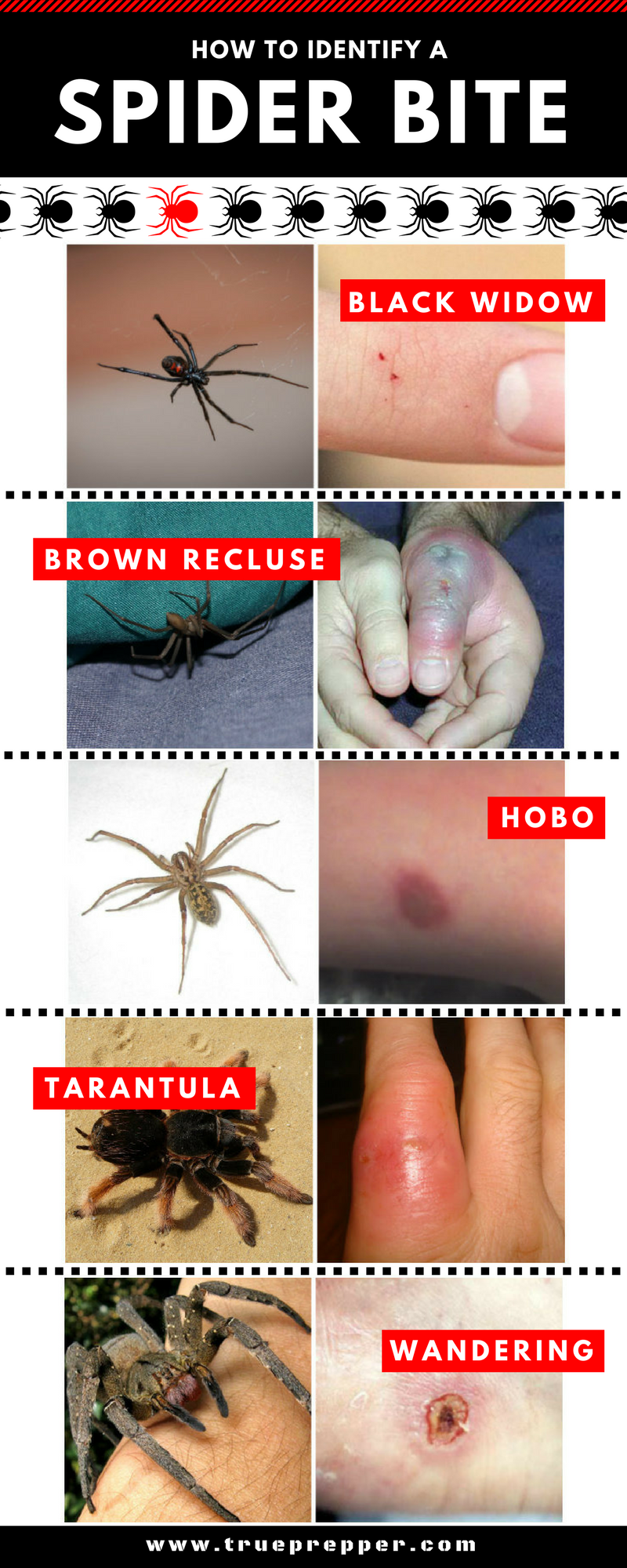How to Identify a Spider Bite and Treat It
Feeling a sharp sting and then finding an unknown spider bite can be a disturbing experience. If you know which symptoms are dangerous, and the basics of how to treat dangerous spider bites, you will be one step ahead.
Learning to identify a spider bite is important so you can know the risks and how to treat the bite. Some spiders can cause tissue necrosis, paralysis, and even death. But others can hardly break the skin and they don’t have venom toxic to humans. This is one reason an unknown spider bite can be unsettling; you simply don’t know what you are up against until the symptoms appear.
Shaking out your boots and gloves before you put them on and checking sleeping bags before you climb in is always a good idea. Don’t get caught off guard, and if you do- don’t panic. Just find the spider, seek medical help if needed, and treat the bite.
Contents (Jump to a Section)
Try to Find the Spider
The best way to find out what kind of spider bit you is pretty simple: find the spider. If you can find the actual spider, you should have no trouble identifying it based on size, color, and markings.
If you still don’t have any clue as to what type of spider it is, you can consider capturing or killing it and bringing it with you when you are seeking medical attention. Spiders that require antivenom are pretty easy to identify in the bright lights of a medical facility.
Almost All Spiders are Venomous
While that may sound pretty bad, most spiders in America are not poisonous to humans. Out of the spiders that do have venom dangerous to humans, only a few of them can actually break skin with their bite.
That leaves only a handful that are dangerous enough to do some serious damage if the bite is left unattended. Even then, the results of a spider can vary from person to person and spider to spider.
Spiders that Require Medical Attention
There are only a handful of spiders that require everyone to get medical attention for their bites. They are well known because of this, and you should recognize most (if not all) on this list:
- Black Widow
- Hobo Spider
- Wandering Spider
- Brown Recluse
- Tarantula
Of these spiders, the ones that you really need to be aware of if you live in the US are the Black Widow and Brown Recluse. Other spiders can cause issues for people with allergies or other conditions or can cause issues localized to the bite area, but the Black Widow and Brown Recluse are the most problematic.
Black Widow Spider Bite
Everyone knows what a black widow looks like, with its distinctive red hourglass on its abdomen. It is a little-known fact that only females are venomous. The bites themselves are like a pinprick and you may feel nothing. The reaction from the venom is quick, though, and pain and burning will spread from the location of the bite.
Black widow spiders are common all throughout the US, so you should definitely be able to recognize one. Here is a picture of a black widow spider and a black widow spider bite:
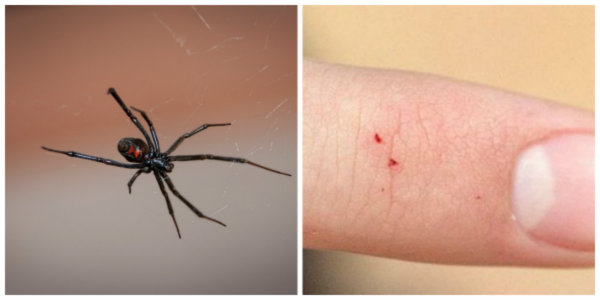
Additional symptoms include:
- Numbness
- Nausea
- Headache
- Muscle Cramping
- Sweating
Brown Recluse Spider Bite
Brown recluse spiders are small and aren’t very aggressive – but they still pack a punch. The site may not be painful, and the venom takes a while to take effect, so you may not notice the bite at all. Soon it will itch and develop a red ring around the bite area. From here it will blister and possibly cause tissue necrosis. Antibiotics and possibly even surgery are used to treat brown recluse bites.
Brown recluses are more common in the southern part of the US- especially from Texas to Georgia. Here is a picture of a brown recluse spider and a brown recluse spider bite:
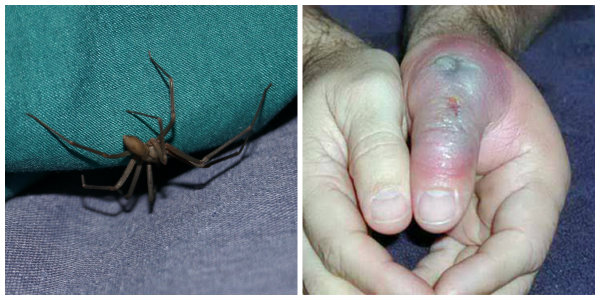
Additional symptoms include:
- Kidney Failure
- Seizure
- Coma
Hobo Spider Bite
Hobo spiders are localized to the Pacific Northwest. Unlike many other spiders on the list, they can attack unprovoked. The bite can be painless, but the venom starts reacting within 15 minutes causing pain and numbness.
Here is a picture of a hobo spider and a hobo spider bite:
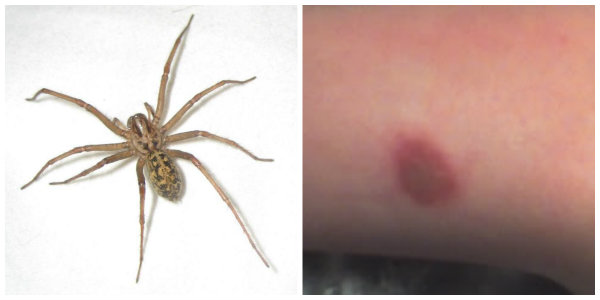
Additional symptoms include:
- Nausea
- Headache
- Weakness
- Joint Pain
- Sweating
Wandering Spider Bite
Brazilian wandering spiders aren’t just stuck in Brazil- they can be found in Central and South America as well. The bite is very painful, and the venom starts reacting immediately, causing sweating and drooling. Antivenom is important to seek out when bitten since the bites can cause death.
Here is a picture of a Brazilian wandering spider and a wandering spider bite:
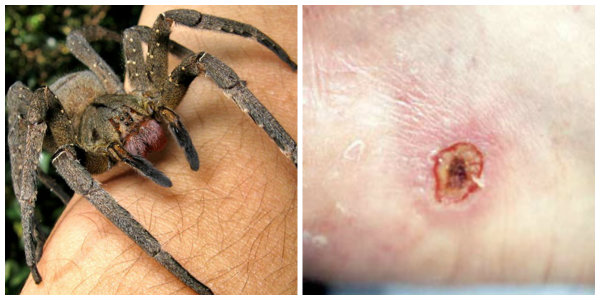
Additional symptoms include:
- Tissue Necrosis
- Burning Skin
Tarantula Spider Bite
Tarantulas enjoy desert climates, and some are even kept as pets. They are large, hairy, and have visible fangs. Although venomous, the bites don’t pose a threat to life and limb. The bites are a sharp pain, and the venom causes the area to swell and become warm.
Here is a picture of a tarantula spider bite:

Additional symptoms include:
- Rash
- Itching
- Trouble Breathing
Other Spiders Known for Their Bites
These spiders won’t give you bites that have you showing up in the ER any time soon, but they still are well known to test out their chompers.
Wolf Spiders: These hairy spiders run pretty fast. They are larger than most spiders, so a wolf spider bite can easily break the skin. Fortunately, their venom is not very effective against humans and bites can be treated like a typical spider bite.
Camel Spiders: These freakish-looking arachnids are brown, gray, or tan and live in warm desert climates around the world. They are usually nocturnal and are attracted to light. Camel spiders don’t carry dangerous venom, but they have large mandible jaws that can be very painful when they bite. If the camel spider is large enough, it can cause profuse bleeding.
Mouse Spiders: Also known as Missulena, these spiders are mostly native to Australia. Bites from these spiders can cause health problems if they are not attended to. Luckily, bites are not common.
House Spiders: House spiders come in a few different varieties. Domestic house spiders are also known as barn funnel weavers and are typically harmless even though they can be confused with a brown recluse because of their size and color. The southern house spider is also pretty harmless although it is bigger. The common house spider has a bite that is painful and can cause mild swelling. They are typically found in basements and crawlspaces.
Parson Spiders: Also known as the eastern parson spider, the parson spider is found mostly in the central US. A parson spider bite is rarely painful, but they still do bite.
Jumping Spiders: These spiders can be pretty surprising considering they jump and can be fairly large. The good news is that they are mostly found outside in the woods. Deal with the bite as you would any regular spider.
Sac Spiders: These yellow spiders can appear brownish in dim light, allowing them to be often confused with a brown recluse. Unlike the recluse, they don’t have any violin-shaped markings and appear much lighter. If you get a sac spider bite, you want to treat it as we detail below even though it can be very painful.
Treating a ‘Regular’ Spider Bite at Home
While they typically do not require treatment, some larger spider bites can cause itching and possible infection (especially if you scratch the affected area). Here are some tips to help prevent this:
- Clean the bite with soap and water or peroxide (prevent infection)
- Elevate the bite if possible (reduces swelling)
- Take an antihistamine (reduces itching)
- Apply ice in intervals (reduces swelling)
- Use antibiotic ointment, especially if it blisters (prevent infection)
Even spiders that don’t pose a threat with their venom can still cause serious damage through exposure and infection. Infection was a steady killer before modern medicine, where humans have the ability to clean their wounds. There is no such thing as over-cleaning a bite, so make sure you get it free of dirt, debris, and bacteria.
The Final Word
Many people have an irrational fear of spiders. Just knowing a little bit about spiders can go a long way in preparing you to deal with them. Bites are pretty easy to manage if you know what you are looking for. Sometimes the battle is figuring out what type of bug bit you rather than what spider. Certain bug bites also cause two puncture wounds that are typically the signature of spiders.
One of the more rare spiders, the Sydney Funnel Web Spider, has a bite that can kill within just a few hours! Luckily, it is not widespread and there is a robust antivenin program making deaths extremely rare. This video goes into the effects of the bite and the spider itself in detail:
There are plenty of animals out there that bite, so be ready for any of them. Our subscribers have found these guides helpful:
- How to Identify Venomous Snakes in America
- Ticks and Lyme Disease – The CDC’s Plea for Help
- Survival First Aid Kit Guide, Tips, and Checklist
Keep exploring, stay prepared, and be safe.
You’ve Been Missing Out
Join the 2+ million preppers that rely on our prepping advice by subscribing to TruePrepper.- Practical guides and tips
- Useful survival giveaways
- Free, forever
- < 0.4% of people unsubscribe
